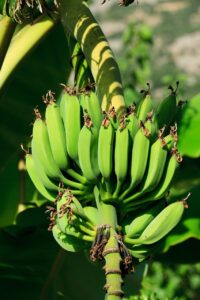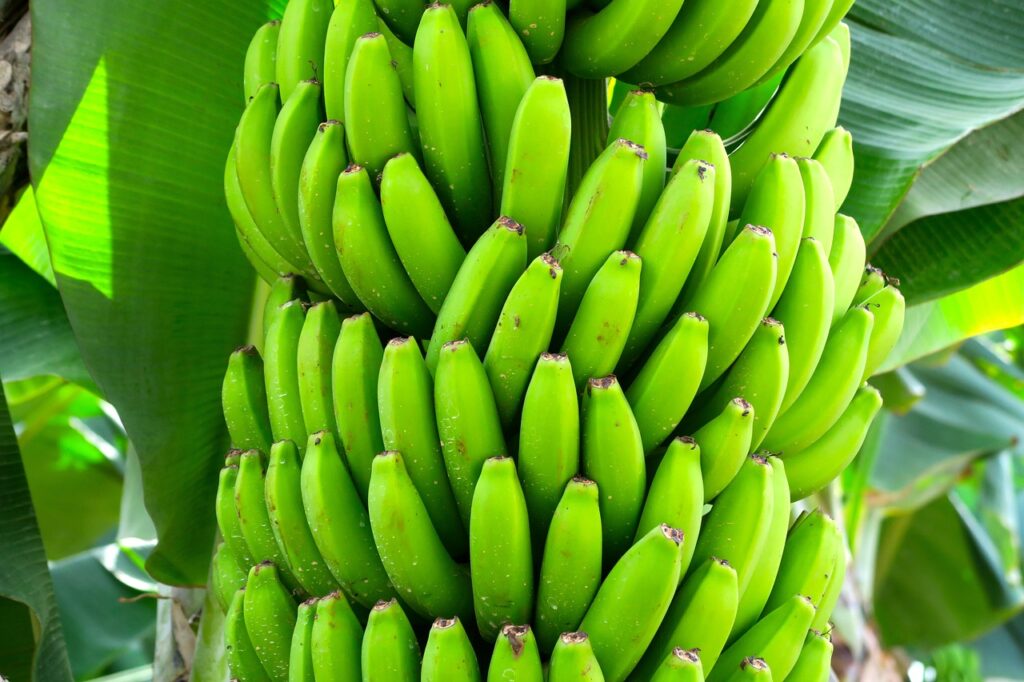Banana Botany
Contrary to popular belief, bananas don’t grow on trees. They are technically berries that grow on a herbaceous plant, known as a ‘banana plant’, which is often mistaken for a tree due to its tall, tree-like structure. The ‘trunk’, known as a pseudostem, is actually a tight cylinder of overlapping leaf bases.
Bananas, as we know them, are of the species Musa sapientum, which has several subspecies. The most commonly consumed variety worldwide is the Cavendish, named after British horticulturist Sir Henry Cavendish who cultivated it in his greenhouse in the 19th century.
Banana Cultivation Process

Banana cultivation starts with planting suckers, which are shoots that grow from a mature plant’s rhizome in well-drained, rich, loamy soil. Once planted, it takes about 9 to 12 months for a banana plant to mature and produce a bunch of bananas.
The plant develops a true stem, which pushes its way up through the centre, culminating in an inflorescence – a spectacular flower head, also known as the ‘banana heart’. The banana heart consists of multiple clusters (hands) of bananas, known as ‘fingers’. Each plant typically produces a single bunch of bananas, after which it dies and is replaced by a sucker that sprouts from the base of the plant.
Unique Aspects of Banana Cultivation
Bananas are unique in the sense that they do not require pollination to bear fruit, a phenomenon called parthenocarpy. This is a significant advantage for large-scale production since growers don’t have to worry about pollinators or lack thereof.
Moreover, cultivated bananas are triploid, meaning they have three sets of chromosomes, resulting in seeds that are virtually absent or too small to be noticed. This is why the bananas you buy at the grocery store are seedless.
The Challenge: Panama Disease
Banana cultivation, while seemingly straightforward, faces a significant challenge in the form of Panama disease, a plant disease of the roots caused by the fungus Fusarium oxysporum. This fungus has ravaged banana plantations worldwide, and the current strain (Tropical Race 4) affects the Cavendish bananas.
The lack of genetic diversity among the Cavendish bananas leaves them particularly vulnerable to disease outbreaks. Scientists worldwide are racing against time to develop disease-resistant varieties through cross-breeding and genetic modification.
Sustainability in Banana Cultivation
Like many forms of intensive farming, banana cultivation has its share of environmental impacts, including habitat destruction, pesticide use, and water pollution. Sustainability in banana farming involves finding ways to mitigate these impacts. This could include practices such as organic farming, integrated pest management, and fair-trade certification, which can also ensure better conditions for banana workers.
Conclusion
The ubiquitous banana is a testament to the marvels of agricultural science and human ingenuity. However, the journey from a banana plant to your kitchen isn’t without its challenges. Understanding the science behind banana cultivation not only brings us closer to our food but also emphasizes the need for sustainable and disease-resistant farming practices to ensure this beloved fruit continues to grace our tables for generations to come.



